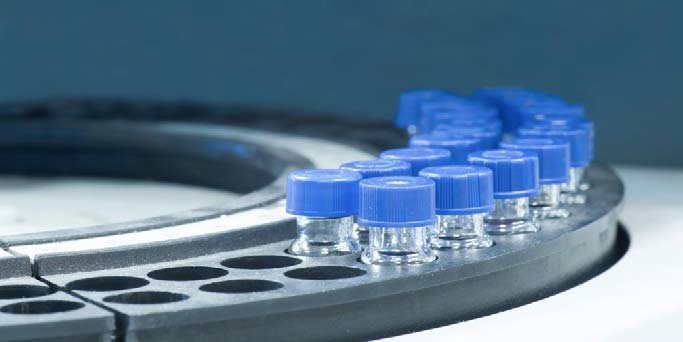By: Paula Clarke, Forensic Science Ireland. Alison Wake, Genevac Ltd.
Introduction
A method for the extraction of drugs of abuse from urine samples pertaining to drug facilitated sexual assault cases has been developed in house by Forensic Science Ireland (FSI). The method involves the use of solid phase extraction techniques prior to screening analysis by LCMSMS. As part of the solid phase extraction process, the extracted sample eluent is evaporated to dryness. FSI evaluated the use of a Genevac EZ‐2 personal evaporator (Figure 1) as an alternative method of evaporation as part of their validation process.
The EZ‐2 was chosen due the fact that it eliminated the need for gases such as nitrogen, required for the conventional blow down evaporation method, and also reduced sample handling and reformatting stages.
Sample preparation method
Urine samples (1ml) are first hydrolysed by incubation with 500ul ß‐glucuronidase enzyme (prepared in 0.1M acetate buffer) for 1ó to 2hr at 60C. 100ul of deuterated internal standard is also added. Following centrifugation at 13,000rpm for 2min the supernatant is removed and 1ml borate buffer added to adjust the pH to ~9.
SPE extraction is carried out using a 3cc 60mg SPE cartridge as follows:
- Condition ‐ 3ml MeOH
- Equilibrate ‐ 3ml Water
- Load sample
- Wash ‐ 3ml 5%MeOH
- Max pressure 50psi for 5 mins to dry bed
- Turn off Flow Rate
- Elute ‐1ml MeOH
- Elute ‐ 1ml 3:1 MeOH:IPA
- Max pressure to drive off remaining eluent
The resultant 6ml of eluent must then be evaporated to dryness and reconstituted in 200ul diluent prior to analysis by LCMSMS.


Choice of Evaporation Procedure
Under the conventional method, evaporation was achieved using a nitrogen blow down system. Evaporation of the eluent by blow down in the SPE fraction collection tube results in the analytes being deposited up the sides of the tube. With a reconstitution volume of only 200ul, it is difficult to ensure that all the analytes have been resuspended. To ensure maximum recovery, evaporation needed to carried out in the MS analysis vial; the 6ml of eluent being added in 2ml aliquots and evaporated to dryness in three stages.
The EZ‐2 (Figure 1) is a centrifugal evaporation system, which works by boiling solvent at low temperature under vacuum.
During evaporation the samples are centrifuged at around 500G primarily to prevent bumping and subsequent cross contamination between the multiple samples which are being dried in parallel. Centrifugation also results in the dried analyte being deposited at the base of the tube. Reconstitution in very low volumes is therefore possible. Using the EZ‐2, the full 6ml of eluent sample can be dried and subsequently reconstituted to 200ul diluent directly in the SPE fraction collection tube.
The EZ2 was evaluated in terms of its ability in achieving required limits of detection, sample integrity and the risk of cross contamination.
Limit of Detection Study
The FSI urine screening method by LCMSMS covers a wide range of drugs of abuse. UNODC’s (United Nations Office on Drugs and Crime) Minimum Required Performance Limit (MRPL) were achieved for all drugs / metabolites listed in the FSI screening panel using the EZ2. Studies performed by FSI showed that increased sensitivity was achieved by using the Genevac EZ2 evaporator compared to other conventional evaporation techniques. For example at the recommended UNODC MRPL, greater sensitivity was achieved when using the EZ2 for 7‐Aminoflunitrazepam, Morphine, Amphetamine and Phenazepam among others, when compared other common methods of evaporation.
Sample Integrity Study
A parallel study was performed using the conventional blow down method versus the EZ2 as a means of evaporation. The conventional process involved evaporation at a temperature of 45°C whereas the use of the EZ2 allowed evaporation at a lower temperature of 40° C to be achieved with sample integrity being maintained. Additionally, the time taken to complete the evaporation process was halved by using the EZ2.
Cross Contamination Study
The aim of the cross contamination study was to determine if any cross contamination occurred during the evaporation process in the Genevac EZ2 for common targeted drugs of abuse in urine samples related to drug facilitated sexual assaults.
The study involved using the EZ2 to evaporate to dryness a series of spiked urine samples, which had undergone solid phase extraction. Each spiked urine sample contained 43 various drugs of abuse / metabolites at a concentration of 500ng/ml in addition to 6 deuterated internal standards*.
The extracted sample eluent from the spiked urine sample was held in a 6ml fraction collection tube and was placed in the sample holder surrounded by fraction collection tubes of blank eluent – known as the ‘blank sample’. All samples (spiked urine and blanks samples) were evaporated to dryness in the EZ‐2, reconstituted in diluent and analysed by LCMSMS.
For the spiked urine samples all drugs / metabolites were detected. All the ‘blank’ tubes, surrounding the spiked urine samples were negative indicating that cross contamination did not occur during the evaporation process using the EZ2.
Conclusions
The experiments performed by FSI have all indicated that evaporation using the EZ2 results in a more streamlined process. Less time is required for completion of the evaporation process and sample integrity is maintained. Increased sensitivity was also achieved without the risk of cross contamination – ultimately a more superior process to conventional methods of evaporation. The method has been accepted into routine use.
*Drugs / Metabolites and Deuterated Internal Standards contained in the spiked urine sample:
Chlordiazepoxide, Flurazepam, Zopiclone, MBDB, Diamorphine, Oxycodone, Norbuprenorphine, Temazepam, Midazolam, Oxazepam, Clobazam, MDEA, Hydromorphone, Dihydrocodeine, Methamphetamine, Methadone, Morphine, THC, THC‐COOH, 7‐ Aminoflunitrazepam, Clonazepam, Nitrazepam, Cocaine, Diazepam, Alprazolam, Lignocaine, MDMA, Amitriptyline, Codeine, Nordiazepam, Lorazepam, Phenacetin, Amphetamine, Zolpidem, Buprenorphine, Bromazepam, 6‐Monoacetylmorphine, MDA, Phenazepam, Ketamine, Triazolam, Flunitrazepam, Benzoylecgonine, Cocaine‐d3, Codeine‐d6, Amphetamine‐d11, THC‐d3, Diazepam-d5, Methadone‐d9
